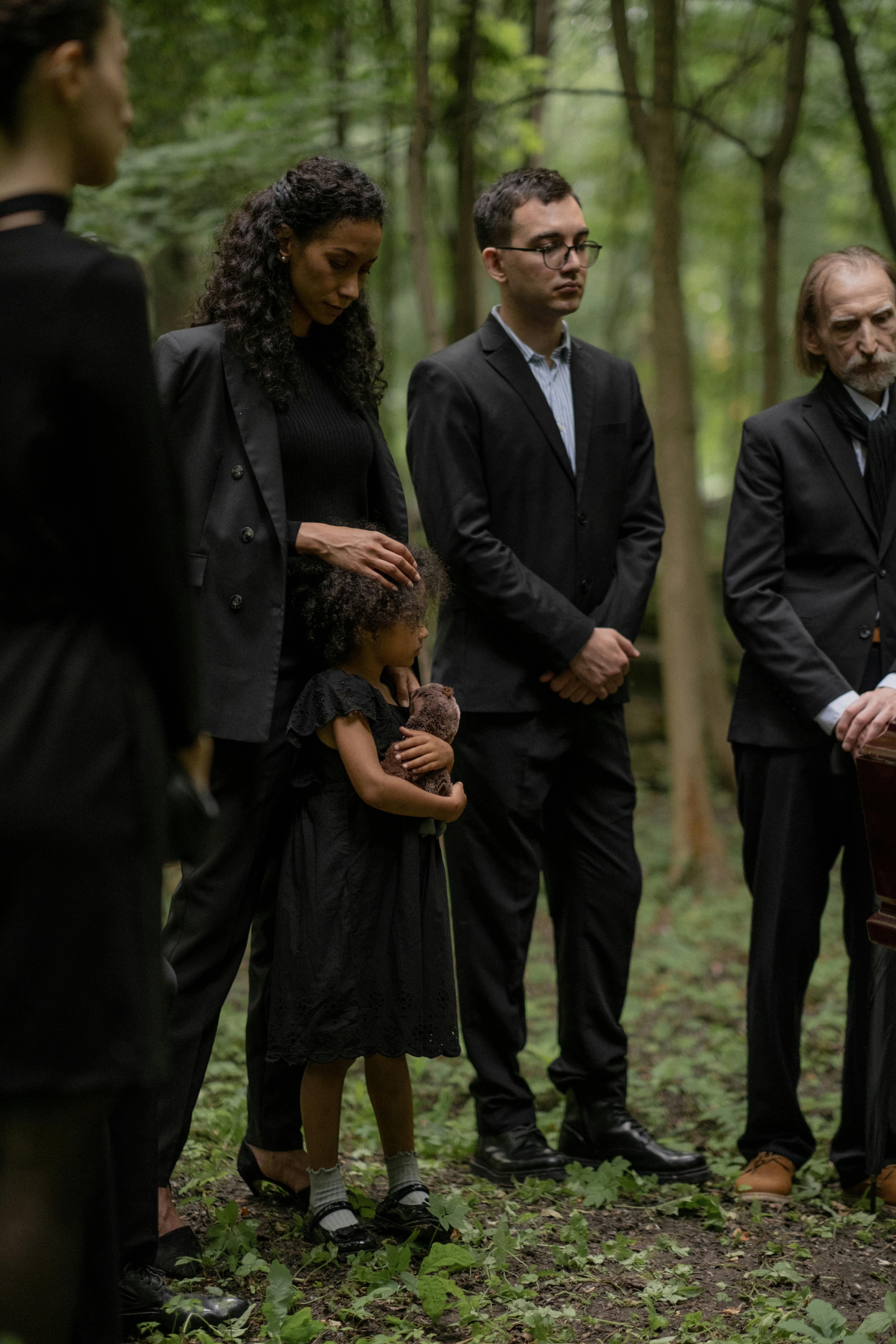
Attending a funeral is a moment to show respect, both to the deceased and their loved ones. In the UK, funeral attire traditionally leans towards sombre and conservative choices, though customs are evolving. Whether you’re attending a religious service, cremation, or celebration of life, understanding what to wear is essential. Choosing a dress code is an important part of the funeral planning process, so it is a good idea to respect the wishes of the family arranging the funeral. This guide offers helpful advice on what to wear to a funeral in the UK, ensuring you dress appropriately for the occasion. If you are planning a funeral and want to note down specific arrangements, such as a dress code, you can add this to your personalised funeral plan on The Farewell Guide’s website.
1. Traditional Funeral Attire
In the UK, funeral attire has historically been black or dark in colour. Black remains the most traditional choice, symbolising mourning and respect for the deceased. However, navy, charcoal, and other muted tones are also widely accepted.
-
For Men: A black or dark-coloured suit, white or neutral shirt, and black tie are the most common choices. Finish with black shoes and minimal accessories. If the family requests a more relaxed dress code, a dark blazer and smart trousers may also be appropriate.
-
For Women: A dark-coloured dress, skirt suit, or trouser suit is traditional. Knee-length dresses, tailored skirts, or trousers paired with a modest top or blouse are ideal. Avoid bright patterns or overly casual clothing, and pair your outfit with simple accessories and black or dark shoes.
2. Modern and Less Formal Funerals
Funerals in the UK are becoming more varied in how they are conducted. Some families may request that guests wear something specific or avoid black altogether, opting for a more celebratory dress code that reflects the personality of the deceased.
-
Bright Colours: Some families might ask attendees to wear brighter colours or even a specific colour that held special meaning to the deceased. It’s important to respect these wishes, even if they go against the traditional norms.
-
Casual or Themed Funerals: In some cases, funerals can be themed or more casual. For example, outdoor or nature-themed funerals may call for more comfortable clothing like smart casual attire or colours that blend with nature. Always adhere to the family’s request.
3. Consider the Venue
The location of the funeral service can also influence what you wear.
-
Church or Religious Service: For traditional church or religious funerals, conservative attire is expected. Dark suits or dresses are appropriate. For women, covering your shoulders in more formal religious settings is a good idea. It may also be necessary to wear a head covering, such as in Catholic or Muslim funerals, so it's helpful to be mindful of religious customs.
-
Crematorium: If the funeral is being held at a crematorium, the dress code is typically similar to that of a church service but can sometimes be more relaxed. Smart, respectful attire is still the norm, and sticking to darker colours is a safe option.
-
Outdoors: If the funeral is outdoors, such as a woodland or green burial, consider practical choices. Dark clothing is still suitable, but you may want to choose shoes and outerwear that accommodate the weather and terrain, such as a coat or umbrella for rain.
4. What to Avoid
While the UK funeral dress code has evolved, there are still some key things to avoid:
-
Bright or flashy colours (unless requested by the family)
-
Overly casual clothing: This includes jeans, trainers, or t-shirts, unless the family has explicitly indicated casual attire is acceptable.
-
Revealing or overly bold outfits: Stick to modest, respectful choices that reflect the occasion.
5. Cultural Considerations
The UK is home to a wide range of cultures and religious practices, which can influence funeral dress codes. In some cultures, white may be worn instead of black to symbolise mourning, such as in Hindu and Buddhist traditions. It’s important to understand the cultural or religious context of the funeral you’re attending, and if you’re unsure, politely ask the family or close friends for guidance.
6. Practical Tips
-
Weather: The UK weather is unpredictable, so be prepared. For colder months, a dark overcoat, scarf, or gloves can be both practical and respectful. In warmer weather, breathable, modest clothing in darker shades is ideal.
-
Comfort: Funerals can be long, with some services lasting several hours. Wear comfortable shoes, particularly if there will be a graveside service where you’ll be standing for an extended period.
7. What Children Should Wear
If you’re bringing children to a funeral, dress them in smart, respectful clothing. For boys, a shirt and trousers are appropriate, while girls can wear a simple dress or skirt. Aim for muted colours similar to what adults wear, and avoid overly casual or brightly coloured clothing.
When attending a funeral in the UK, it’s important to remember that your presence and behaviour are more important than what you wear. However, dressing appropriately is a way of showing respect. Whether adhering to traditional black, following the family’s unique dress code, or taking into account cultural practices, your outfit should be thoughtful, respectful, and modest. Always check for any special requests from the family and dress accordingly to honour the memory of the person who has passed away.
Funeral dress codes can vary but showing respect through understated and appropriate clothing will ensure you’re dressed suitably for the occasion. If you are planning a funeral and want to note down specific arrangements, such as a dress code, you can add this to your personalised funeral plan on The Farewell Guide’s website.
Related Articles:
What is a Funeral Wake?
What I've Learned About Loss: A Guide on How to Speak to the Bereaved by Dilys Morgan of the 'Living With Dying' Podcast
10 Alternatives to Sympathy Flowers